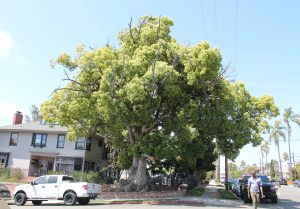
A pilot program is underway to showcase the many significant trees, from young to old, in Bankers Hill through self-guided walking tours.


Brian Bagnall, District 3’s representative on the Community Forest Advisory Board (CFAB), had the idea for Happy Tree Walks in February when the board sought new ways to engage the community.
In the past months, he has developed four walks through the urban neighborhood which highlight historic sites, favorite small businesses, and of course, its trees. Information on century-old houses, the AIDS Memorial in Olive Street Park, and heritage trees provide additional context to the walks.
Plus, he recommends local businesses like Cafe Bassam to sip tea at after undertaking one of the walks.
“These [trees] are part of our community too.” – Emma Smith
He brought a dual focus on happiness and livability meant to have locals and tourists alike appreciate the environment around them as they explore urban San Diego from a new perspective.
“One of the most important things for all people, particularly living in cities now, is get out and walk more. It’s the best thing you can do for your health. It’s the best thing you can do for your spirit,” Bagnall said.
He funded the project and brought on Emma Smith from Kate Sessions Commitment. She created the website for people to follow on the walks and learn about the community with detailed directions and photos.

One walk starts in Balboa Park West highlighting the historic trees once planted by Kate Sessions. The next option starts in Olive Street Park, with its many new-growth trees in need of community care, before meandering over two canyons crossed by historic bridges. Another walk along Fifth Avenue has less trees but highlights the modern village life with the street’s many mixed-use buildings. With floral explosions popular in April and May, a final walk takes visitors to the many Jacaranda trees sprinkled across Bankers Hill.
The walks do not inventory every tree in the neighborhood. Instead they highlight a path for people to walk past a variety of tree species of all ages. “There’s so many treasures we don’t even let you know about. You have to find [them] yourself,” Smith said.
The limited information on the website was intentional, with the hope people would not be overwhelmed. For those who want to go deeper, they could instead use tools like the Seek app by iNaturalist if they want to identify species and learn more.
Rather than education, the focus is on appreciation of how trees add to the urban environment. Even amid the construction projects and traffic of Bankers Hill, the canyons surrounded by trees muffled noise pollution so peace could be found in nature despite being in the center of an urban core.
“We didn’t want it to be too techie about trees. You don’t have to be a tree expert,” Bagnall said. “We didn’t want to clutter the site with too much information.”
Starting the project in Bankers Hill was significant as Uptown has the densest tree canopy in San Diego, at 24% in 2014, close to the national average of 26%. In comparison, 13% of San Diego as a whole was shaded by trees in the 2014 count.
Bankers Hill had more opportunities to add greenery in the past decade, with street trees and Olive Street Park adding to the tree cover. Many of these are comparatively small and still getting established in the dry environment compared to the massive historic trees on private property in Bankers Hill or in canyons with less human interference.
“When we go on this walk, we see how grand trees can be, and then to look next next door at our street trees and see the difference, it kind of puts it in perspective,” Smith said.

Between the Maple Canyon overlook at the AIDS Memorial, San Diego’s oldest bridge the Quince Street Footbridge built in 1905, and the Spruce Street Suspension Footbridge, the Olive St. + Bridges walk gives people the opportunity to feel as if they are part of the tree canopy. High up, they can view the canyons with its plants and trees.
She hopes highlighting the new trees in Olive Street Park will raise awareness of their need for watering from the community in addition to the city’s maintenance. Already, some of the trees have died and been replaced.
“These [trees] are part of our community too. I think it’s a powerful story in this park with the AIDS Memorial, because when we do have the people championing a story, things get better,” Smith said. “I want to see people engage with the trees more.”
Smith and Bagnall are looking for feedback on the pilot program.
To take one of the walks, visit sites.google.com/katestrees.org/our-happy-tree-walks-sd/home.
Top photo: The canyons in Bankers Hill are a quiet, peaceful break from the traffic and construction of the surrounding streets. (Photos by Drew Sitton)











Discussion about this post